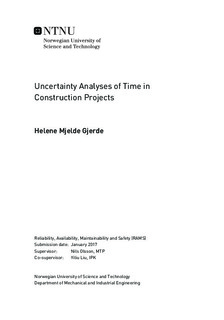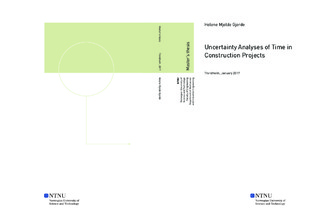| dc.description.abstract | The aim of this master thesis is to investigate how uncertainty analysis on time can contribute to a better foundation for decision-making in the project planning phase, and by this reduce the total time spent in this phase. This thesis has been conducted as part of SpeedUp research project and in cooperation with OPAK.
Both qualitative and quantitative research methods have been used in this master thesis, including a literature study and an exploratory case study. The case study further included interviews, an uncertainty analysis workshop on time, and scenario simulation using the software SimVision. The elected case study is a real life construction project in early planning phase, managed by OPAK.
An identified research gap on literature within the field of uncertainty analyses on time, and specifically literature focusing on how results from uncertainty analyses are analyzed and used, motivated the research in this thesis. Alternative methods, also explained in the theory chapter, which caught the author s interest were Thamhain (2013) s division of uncertainty into dimensions and the theory of System Dynamics presented by Jay Wright Forrester.
By conducting semi-structured interviews in OPAK the current procedure of uncertainty analyses on time were found to be in accordance with the Trinnvisprosessen and the Successive principle by Steen Lichtenberg, which were verified in the workshop. An interest for additional methods that would increase the probability of project success was also highlighted through interviews.
Among the findings in this thesis is an approach to adapt a construction project into a simulation software. Chapter 6 presents a short description of how to model projects in SimVision simulation software, with explanation of the general modelling elements and how to adjust the program functionality through various project settings. The simulation showed a relation to the system dynamics theory, combining system processes and behavioral factors as communication, formalization and centralization. Through scenario generation, the study showed that the degree of predictability within a project could increase by the usage of SimVision.
The elected framework for the simulation was early phase of a construction project, where a small amount of people conducted coordination-based activities that required high degree of communication. The findings from simulation showed that increased resources in each task would bring down the projects total duration. This may vary from reality, as more people to coordinate the coordination would delay the process. The author suggests a framework within a project phase with higher amount of resources, which does not have coordinative roles.
SimVision has been found to be a possible optimization tool towards forward scheduling, where project duration is defined by total activity duration, including several factors affecting duration, contrary to a traditional uncertainty analysis where estimates are made by people based on knowledge and experience. | |

